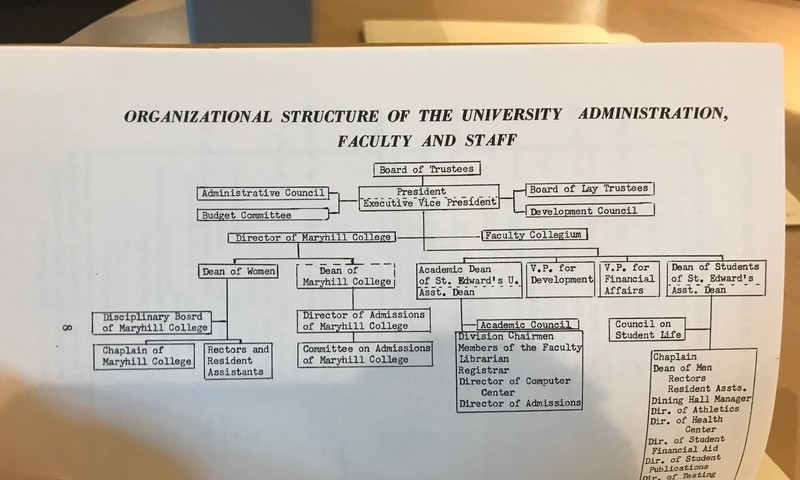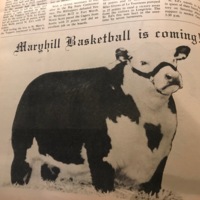Where Women Stood: Incidental Status
Maryhill & the Coordinate System
In the fall of 1966, St. Edward’s University opened its campus to women through the newly established coordinate college. Maryhill College was established as a program for the education of women, that allowed them to pursue a degree in an environment that emphasized the differences between men and women’s academic needs.
Incidental Status
The 1969 print of the St. Edward’s University Handbook included a section titled “Organizational Structure of the University Administration” that provided a visual representation of the university’s administrative hierarchy. Although St. Edward’s and Maryhill were marketed as coordinate colleges, administrative roles for the women’s college were portrayed as equivalent to the St. Edward’s Faculty Collegium.[1] This is a striking, but clear demonstration of how the women’s college struggled to gain administrative support. Maryhill shared the St. Edward’s campus, but was not a part of it. Instead, Maryhill was presented as another subdivision of St. Edward’s, not integral to the university itself. This notion that Maryhill was an “afterthought” or “subdivision” not only applies for the women’s college, but for the women themselves.
Maryhill students were regarded as what historian Linda Eisenmann refers to as “incidental students.” Eisenmann argues that women who who pursued higher education were considered incidental, because men believed their endeavor for a degree would not amount to a lifelong career, but rather a postponement of domesticated life.[2] The coordinate system operated with the understanding that men and women needed separate college environments that catered to their specific academic needs. Sister Mary Kevin stated, “The coordinate system tries to take care of the needs of a woman that are hers, because she is specifically a woman.”[3] Women were not taken seriously in their academic career, and this incidental status also spilled over into the athletic and social scenes on campus.
Women Are No Big Deal
On February 14, 1969, The Hilltopper published an ad promoting the formation of Maryhill’s basketball team. Under the title was a large image of a cow. Although Maryhill students had been asking for more coverage in the newspaper, this is not what they had in mind. One month later, St. Edward’s student Daniel Clifford published “An Immodest Proposal.” He proposed the school give him funding to convert the third floor of Main Building into a brothel.[4] Through the strong use of satire, Clifford demonstrates the sexist attitude that prevailed on campus. Unfortunately, public embarrassment of women was not limited to newspaper publications, for the first two years of Maryhill’s existence, panty raids were a weekend tradition.[5] This perspective and treatment of women severely undermined their ability to successfully integrate themselves on campus during their first years. The administrative hierarchical structure, sexist newspaper articles, and panty-raids, were just examples of how this idea that female students were “incidental” perfused St. Edward’s campus. As long as women were considered incidental, there was no reason to take them, or their education seriously. It was not until women started to fight for their integration through vocalizing their grievances, and attaining leadership roles on campus that they began to make their presence known and accounted for.




